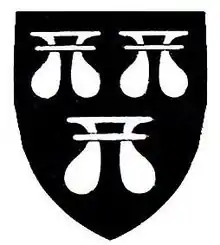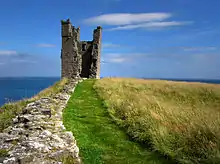House of Lilburn
The House of Lilburn are an ancient family historically seated as Lords of the Manor in Northumberland, United Kingdom.[1] The family name Lilburn (variations include Lilburne, Lilbourn and Lilbourne) derives from the original home of the family, Lilburn, Northumberland. Furthermore, the etymology of the name itself, a combination of the words lily and burne (river), derives from the nature of the Lilburn area, which is described as being by the 'stream where the lillies grow'.[2]
| House of Lilburn | |
|---|---|
 | |
| Country | Kingdom of England, United Kingdom |
| Titles | Earl of Dunstanburgh |
| Estate(s) | Lilburn, Northumberland (15th century) |
Coat of arms


The heraldic blason for the Lilburn coat of arms is a cendree (or sable[4]) field, with three bougets argent (the choice of water bags is presumably due to the pertinence of the house name to the river). The colours can vary slightly and some versions can be found in which the bougets are simplified with three ordinary fusils (or elongated lozenges).[5] The use of ordinaries (the three fusils) demonstrates how the House of Lilburn is one of the first and most ancient names of England.[4] The use of simple and easily recognisable shapes is typical of early heraldry, after which shields were blazoned with increasingly complicated shapes and a variety of charges.[6]
Family history
When the house was founded is unknown, yet the Lilburn name predates the Norman Conquest of England. The Lilburn family name can be found carved into ancient gravestones in the vicinity of West Lilburn Tower, Lilburn, and Lindisfarne (Holy Island), near the medieval priory.[7] The House of Lilburn is said to have been called to arms during the Crusades. In a 14th-century church's graveyard, near West Lilburn Tower, a number of tombs allegedly belong to the Knights Templar, among which some bear the Lilburn name.[8]
In the 17th century John Lilburne and most of his family were key figures in the English Civil Wars (see Prominent members).
Family seat
The House of Lilburn's origine can be traced back to Lilburn, a pre 7th century town located in the Northern reaches of Northumberland, East of the Cheviot Hills. It is recorded in the Domesday Book (1086), referred to with the spelling of Lilleburne.[2] The medieval manors of West and East Lilburn were purchased separately and subsequently united by John Clennell of the Clennell family of Clennell Hall about 1700. In the 1820s the estate was passed on to the Collingwood family of Cornhill, for whom Lilburn Tower was built as a private residence. In the 1970s the private mansion and all its 40 acres on which stood West Lilburn Tower, were sold to the Davidsons.[8] Located where the ancient town of Lilburn was founded, the ruinous remains of West Lilburn Tower, the nearby pele tower and the 14th century church still stand and are scheduled as an Ancient Monument and protected as Listed Buildings (Latitude/Longitude: 55.5110, -1.9671).[9]
Recurring names
In the Lilburn genealogy the most common names include:
- John (first recorded was John de Lilleburn of Yorkshire found in the Subsidy Roll of 1327)
- William (one of the earliest was Sir William de Lilburne, Lord Warden of the Middle Marches in the 13th century)
- George
- Isabel/Isabella[10]
Prominent members


Prominent historical members of the family include:
- Alexander de Lilleburna of Northumberland (1170)
- Robert de Lilburn in 1245 was one of twenty-four knights who surveyed the Scottish-English boundaries.[11]
- Sir John de Lilburn (1279-1355) was the nephew and heir of Christine de Lilburn, through whom he inherited “livery of the manor of Lilburn as one knight’s fee” on October 26, 1324. He was knighted at the King’s Court at Christmas 1315 and a few months after was appointed Constable of Mitford Castle. He added considerably to his lands, including the barony of Stamford and Dunstanburgh, and was appointed Constable of Dunstanburgh Castle in 1323, where he built the famous Lilburn tower, part of which is still standing. He was Commissioner of Array in Northumberland in 1325 and sheriff of Northumberland in from 1327 to 1329. Sir John married Lady Constance de Lilburn (1298-1366) in 1319 and their daughter, also named Constance (1320-1349), married Alan de Heaton of the Heaton family in 1350.[11][12] In a second marriage, to Lady Beatrice de Beauchamp (1280-1347), in 1328 John de Lilburne II was born, who was also knighted.[13]
- His mother, Idonea de Vieuxpont (or Vipont) (1255-1333), was the daughter of Robert de Vieuxpont, II Baron of Westmoreland; Idonea owned Pendragon Castle and founded St Mary's Outhgill in Mallerstang, Cumbria.
- The identity of his father, on the other hand, is uncertain: evidence in a pedigree following visitations in 1575, 1615 and 1666 would suggest he was William de Lilburn, son of Sir William de Lilburn, Lord Warden of the Middle Marches; other genealogical documentation from Northumberland, studying the family from the Vieuxpont side, shows that Sir John de Lilburn could be the son of a Roger (or Robert) de Leybourne of the Leybourne variant of the Lilburn name, historically associated with the county of Kent.[14][15]
- Sir John's great-grandsons:
- John de Lilburne was constable of Alnwick Castle, seat of the House of Percy[11]
- William de Lilburne "received by grant of Robert Ogle of Bothell the manors of Thickley Punchardon and Shildon, o Durham and all messuages, lands etc there"[16]
- Bartholomew Lilburne (1512-1562) attended the Field of the Cloth of Gold[16] and is said to have had made a family armour, the whereabouts of which are currently unknown.[11]
- John Lilburne (1538-1605), son of the above Bartholomew Lilburne, took part in the Rising of the North
- John Lilburne (1614-1657), or John Freeborn, grandson of the above, was a political Leveller and one of the leading figures of the English Civil Wars
- Robert Lilburne (1613–1665), English soldier, brother of the above John Lilburne, signatory to the death warrant of King Charles I in 1649[17]
- John Lilburne (1538-1605), son of the above Bartholomew Lilburne, took part in the Rising of the North
- Bartholomew Lilburne (1512-1562) attended the Field of the Cloth of Gold[16] and is said to have had made a family armour, the whereabouts of which are currently unknown.[11]
(To learn more about the Lilburn family's role in 17th century politics see the appropriate articles: John Lilburne and English Civil Wars)
Prominent contemporary members:
- Tim Lilburn (b. 1950), Canadian poet[18][19]
- Douglas Lilburn ONZ (1915–2001), New Zealand composer[20]
The actor Tom Goodman-Hill, who played John Lilburne in Channel 4's drama The Devil's Whore, is a sixteenth-generation descendant of John Lilburn's uncle, Joseph.
First settlers in other continents
In the United States of America:
- Jane Lilburne Susan Rogers, who married Isham Randolph of Virginia in 1717 and emigrated to Virginia about that time. She was the maternal grandmother of Thomas Jefferson.[21]
- Thomas Lilburn, who arrived in New York City in 1820[22]
In Australia:
References
- "Lilburn Family Crest, Coat of Arms and Name History". houseofnames.com.
- "Surname Database: Lilburn Last Name Origin". The Internet Surname Database.
- http://www.dixclemens.com/bordley/images/crests/william_lilburn.jpg
- "Archived copy". Archived from the original on 2015-06-19. Retrieved 2015-06-19.CS1 maint: archived copy as title (link)
- https://www.houseofnames.com/lilburn-family-crest
- Stephen Friar, Ed. A Dictionary of Heraldry. (Harmony Books, New York: 1987), 259.
- Mackenzie, Eneas (1825). An Historical, Topographical and Descriptive View of the County of Northumberland, Vol. II, pp. 14-15. Newcastle upon Tyne: Mackenzie and Dent.
- "Archived copy". Archived from the original on 2015-06-10. Retrieved 2015-06-09.CS1 maint: archived copy as title (link)
- Good Stuff. "West Lilburn Tower - Lilburn - Northumberland - England - British Listed Buildings". britishlistedbuildings.co.uk.
- "FamilySearch.org". familysearch.org.
- http://freepages.genealogy.rootsweb.ancestry.com/~mcneillyandco/sirjohnlilburne2.htm
- http://www.northumberland-tales.com/Lilburn-tower.html
- http://trees.ancestry.it/tree/32168312/person/19931513357/media/5efccfc9-1ece-4312-8a37-c6f77ea1cd9e?pg=32768&pgpl=pid
- http://www.vieuxpont.co.uk/imagelib/sitebuilder/misc/show_image.html?linkedwidth=actual&linkpath=http://vieuxpont.co.uk/sitebuildercontent/sitebuilderpictures/Vieuxpontpedigre.jpg&target=tlx_new
- Sanders, I.J. English Baronies: A Study of their Origin & Descent 1086-1327, Oxford, 1960. pp.103-4, Appleby, pp23-24, Burgh-by_Sands.
- Gregg, Pauline (2001). Free Born John – Biography of John Lilburne. Phoenix Press. ISBN 1-84212-200-2.CS1 maint: ref=harv (link)
- Andrew Bisset History of the Commonwealth of England – From the Death of Charles I. to the Expulsion of the Long Parliament
- "Moving Images - Tim Lilburn (The Writing Life)". movingimages.ca.
- "UVic Writing :: Faculty :: Tim Lilburn". uvic.ca.
- "Celebrating Lilburn". nzsm.ac.nz.
- https://www.wikitree.com/wiki/Rogers-1
- "Lilburn - New York, Elenchi passeggeri, 1820-1957 - Ancestry.it". ancestry.it.